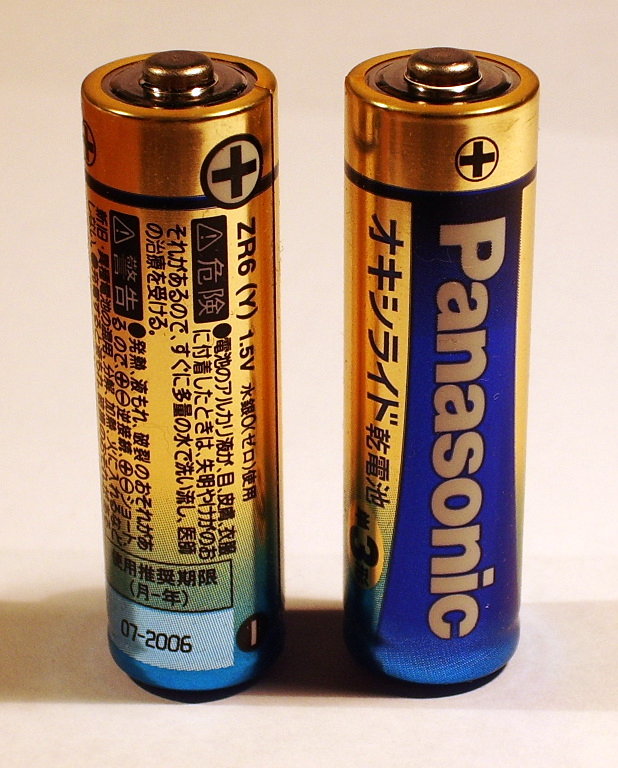Nickel oxyhydroxide battery on:
[Wikipedia]
[Google]
[Amazon]
''Nickel oxyhydroxide battery'' (abbr. NiOx, IEC code: Z) is a type of 

An example of an equipment manufacturer testing nickel oxyhydroxide batteries. Finer grained graphite in the cathode and a vacuum pouring process that inserts a higher quantity of electrolyte in the cell are used during the manufacturing of the nickel oxyhydroxide cells.Katerina E. Aifantis, Stephen Andrew Hackney, Stephen A. Hackney, R. Vasant Kumar (ed) ''High Energy Density Lithium Batteries: Materials, Engineering, Applications'', Wiley-VCH, 2010 page 49
Can a New Disposable Battery Change Your Life? Parts of It, Maybe
by David Pogue
New Consumer Primary Battery Chemistry Introduced after a 40-year Dryspell
Panasonic Oxyride Editorial Review - The Revolution in Battery Power
{{Galvanic cells Disposable batteries
primary cell
A primary battery or primary cell is a battery (a galvanic cell) that is designed to be used once and discarded, and not recharged with electricity and reused like a secondary cell (rechargeable battery). In general, the electrochemical reaction ...
. It is not rechargeable and must be disposed after a single use. NiOx batteries can be used in high-drain applications such as digital cameras.
NiOx batteries used in low-drain applications, have a lifespan similar to an alkaline battery. NiOx batteries produce a higher voltage (1.7V) than alkaline batteries (1.5V) which can cause problems in certain products, such as equipment with incandescent light bulbs
An incandescent light bulb, incandescent lamp or incandescent light globe is an electric light with a wire filament heated until it glows. The filament is enclosed in a glass bulb with a vacuum or inert gas to protect the filament from oxidat ...
(such as flashlights/torches), or devices without a voltage regulator.


Construction
The nickel oxyhydroxide cell is different from a standard alkaline battery in the manufacturing process and in chemical composition. The chemical difference is the addition of nickel oxyhydroxide to themanganese dioxide
Manganese dioxide is the inorganic compound with the formula . This blackish or brown solid occurs naturally as the mineral pyrolusite, which is the main ore of manganese and a component of manganese nodules. The principal use for is for dry-cell ...
and graphite
Graphite () is a crystalline form of the element carbon. It consists of stacked layers of graphene. Graphite occurs naturally and is the most stable form of carbon under standard conditions. Synthetic and natural graphite are consumed on large ...
for the cathode
A cathode is the electrode from which a conventional current leaves a polarized electrical device. This definition can be recalled by using the mnemonic ''CCD'' for ''Cathode Current Departs''. A conventional current describes the direction in whi ...
. This results in an unloaded voltage of 1.7 V DC per cell. The cells sustain a higher average voltage during discharge compared to alkaline batteries. This may cause a false indication in equipment that monitors battery voltage as an indication of remaining operating time.An example of an equipment manufacturer testing nickel oxyhydroxide batteries. Finer grained graphite in the cathode and a vacuum pouring process that inserts a higher quantity of electrolyte in the cell are used during the manufacturing of the nickel oxyhydroxide cells.Katerina E. Aifantis, Stephen Andrew Hackney, Stephen A. Hackney, R. Vasant Kumar (ed) ''High Energy Density Lithium Batteries: Materials, Engineering, Applications'', Wiley-VCH, 2010 page 49
See also
*List of battery types
This list is a summary of notable electric battery types composed of one or more electrochemical cells. Three lists are provided in the table. The primary (non-rechargeable) and secondary (rechargeable) cell lists are lists of battery chemistry ...
References
External links
Can a New Disposable Battery Change Your Life? Parts of It, Maybe
by David Pogue
New Consumer Primary Battery Chemistry Introduced after a 40-year Dryspell
Panasonic Oxyride Editorial Review - The Revolution in Battery Power
{{Galvanic cells Disposable batteries